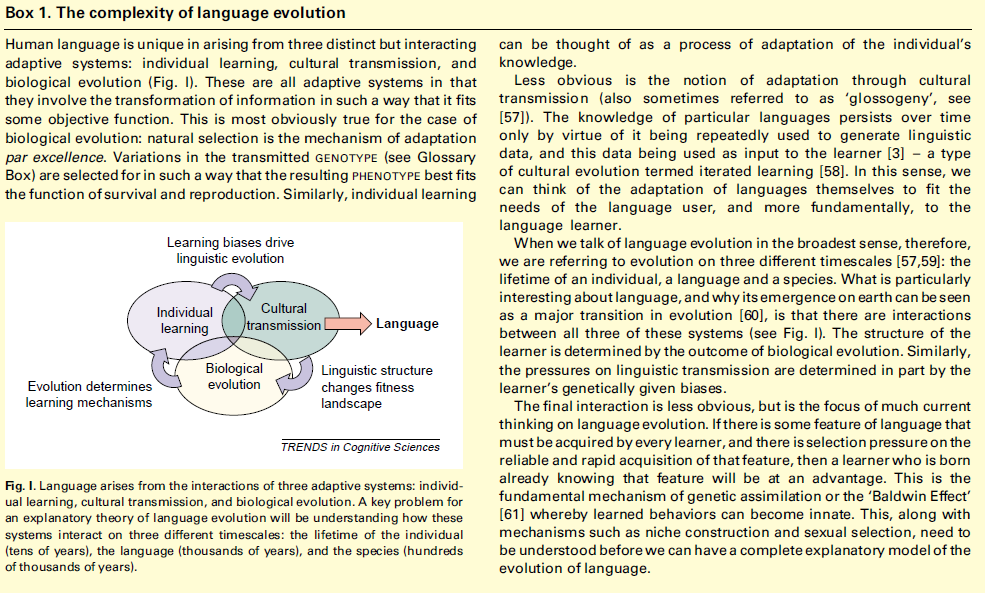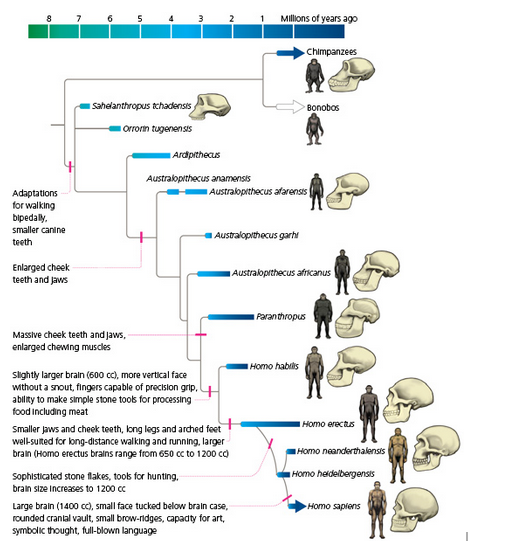Contents
5.1 The co-evolution of humans and language
Much research on the evolution of language has asserted that the phylogenesis, or evolutionary descent, of the homo sapiens species has played a key role in the emergence of language, and not simply because modern humans are language’s sole users (Chater and Christiansen, 2011; Kirby, Cornish & Smith, 2008; Pinker, 2003).
The following figure 3 from Christiansen and Kirby (2003) provides a concise snapshot of the co-evolution of humans and language, as an interaction between three different evolutionary systems: biological evolution (phylogeny), individual differences in learning (ontogeny) and rate of language change.

Figure 3: the co-evolution of humans and language (Christiansen & Kirby, 2003)
Accordingly, by charting the physical and cognitive evolutionary developments in humans, we expect to glean crucial insights into the phylogenesis of language itself. Let’s first begin with a survey of the general phylogenetic history and evolutionary stages of homo sapiens.
[Back to Table of Contents]
5.2 Phylogenetic branching leading to homo sapiens
According to Fitch (2007), the ‘independent evolutionary history’ of humans starts from the last common ancestor (LCA) between chimpanzees and hominids, around ‘seven million years ago’. Hominids, are a sub-branch of primates, and include all known human species, although only one hominid species exists today (i.e. all modern humans), namely homo sapiens.
The following figure pictorially charts the phylogenesis of humans as a specific species of hominids.

Figure 5: The Phylogeny of Humans as adapted from Evolution 101
Additionally, within the hominid branch, two large sub-groups can be located; namely, the earlier genus Australopithecus (includes notably the specific species of anamensis, afarensis, africanus, boisei, robustus) and the later genus Homo (includes notably the specific species of habilis, ergaster, erectus, neanderthalensis, sapiens).
[Back to Table of Contents]
5.3 Adaptive stages leading to homo sapiens
5.3.1 The fossil data record – three stages of hominid adaptations
Given this general phylogenetic picture, palaeontologists have attempted to reconstruct in greater detail the specific evolutionary pathway of modern humans from fossil evidences. Accordingly, some researchers have suggested that the language-using Homo sapiens species emerged from three broad stages of hominid adaptation (Fitch, 2007), which are detailed below.
5.3.2 Adaptation stage 1: Bipedalism
The first major hominid evolutionary adaptation occurred roughly six million years ago (6 mya), in the early human species Australopithecus farensis. Palaeontological analysis on a fossil of this pre-homo hominid species named ‘Lucy’ found clear skeletal evidence for an upright posture. This, in turn, indicated the presence of bipedalism – defined as the mode of locomotion whereby an organism moves by means of its two rear limbs or legs – in this species.
Many scholars believe that the evolution of bipedalism had a huge impact on the cognitive development of later human species (after Australopithecus afarensis). By reducing the need for four-limbed locomotion (e.g. climbing), later human species would have faced a significantly different visual representation of cognitive space and distance, compared to earlier non-bipedal hominids. Further, some scholars also draw a link between the role of imitation systems (mirror neurons, to be elaborated in section 6: cognitive prerequisites) as a primary selective pressure for bipedal locomotion, thus linking bipedalism, imitative abilities and language-learning abilities in an evolutionary chain. Practically and finally, an upright posture would have freed up hands of later hominids to engage in other activities – such as in communicative gestures or tool-making – which has been conjectured to have led to the second major stage of hominid adaptation: brain expansion.
5.3.3 Adaptation stage 2: Basic tool making and Brain expansion
The second major hominid evolutionary adaptation is estimated to have started around the time of the genus Homo. This involved the expansion of the human brain – the neocortex – which is, on average, around 35-60% larger in proportion to a typical primate’s body and brain size. Various scholars have suggested a period just under 4 million years, a relatively short time in evolutionary terms, in which the hominid brain had grown about three times its original size.
Many hypotheses have been made regarding the developmental effects of this brain expansion. This have included suggestions that such a physical adaptation could have resulted in various behavioural peculiarities in humans, such as a theory of mind, intelligence, and other cognitive prerequisites that may account for the human language, including the development of more acute motor skills and greater cognitive capacity.
In other words, this expansion of brain was probably crucial for the development of language. As earlier noted, this adaptation was had occurred quite early – at or near the beginning of the genus Homo itself – specifically in the Broca’s area, the part of the brain closely associated with language. Fossil evidences have helped paleontologists trace the presence of Broca’s area in endocasts from various genus Australopithecus. Wernicke’s area was discovered in fossil records later on, amongst the Homo habilis (Dubuc, n.d).
5.3.4 Adaptation stage 3: Advanced tool making and Motor control
The rise of tool-making, following the freeing of hands due to bipedalism, triggered off the third major stage of hominid evolutionary adaptation.
The development of sophisticated tools is considered a crucial moment in the human evolution, as it set the stage for better nutrition and advanced social behaviours, like the planning and division of labour and group hunting, reinforcing the notion that tool making and language evolved together as both required more complex and advanced cognition.
The parallel of the complexity in the tools made by humans and development of language may imply a correlation between enhanced motor movement and an early form of the human language used to communicate thoughts and intentions. For instance, the design of stone tools have evolved and advanced quickly in the human pre-history, beginning with sharp and primitive stone flakes, and culminating in finely honed and produced hand axes.
Notably, deficits in motor control are also often linked to aphasia in humans. Since there is a strong correlation between manual tool making and speech communication, the investigation on the evolution of humans’ physical and cognitive characteristics and their specific changes offers great promise on ground discussions of language evolution.
[Back to Table of Contents]